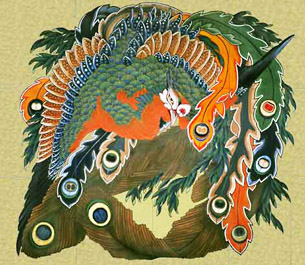 |
|
 |
Katsushika Hokusai, Phoenix Staring in Eight Directions, 1848, 584 x 636 cm, ceiling painting at Gansho-in temple, Obuse.
Photo courtesy of Gansho-in |
|
Visitors to Gansho-in listen to a lecture while craning their necks at the painting overhead. The temple altar has a statue of the historical Buddha Sakyamuni.
Photo courtesy of Gansho-in |
Nestled in the fertile Nagano Basin by the banks of the mighty Chikuma River (Japan's longest), Obuse is a historic town whose farmer-merchants flourished during the Edo period (1603-1867). Today it is a tourist mecca with an "old town" area that includes a number of well-preserved Shogun-era wooden and stucco structures, mixed in with the usual hodgepodge of restaurants and souvenir shops that appear antique but are of much more recent vintage. The resulting Disneylandish ambience can be a bit off-putting, but amid the commercial dreck there are some cultural gems well worth visiting -- particularly those associated with Katsushika Hokusai.
One of Japan's, and perhaps the world's, greatest artists, Hokusai (1760-1849) lived and worked in Obuse for a good part of his twilight years, leaving a legacy of large and colorful masterpieces in the area, notably a series of ceiling paintings that are a marked departure in scale and style from the woodblock prints for which he is best known.
Hokusai's local benefactor was a wealthy merchant named Takai Kozan who wanted to bring some of Edo's cultural cachet to Obuse and had the wherewithal to do so. Introduced by an Edo acquaintance to Hokusai, who was then in his 83rd year and, despite his fame, in dire financial straits, Kozan invited the artist to Obuse, building a small studio for him on the grounds of his mansion in the center of town. Between 1844 and 1848 Hokusai made four extended visits to Obuse, the final one not long before his death at age 89.
 |
|
 |
Home of Hokusai's famed phoenix painting, the Main Hall of Gansho-in temple nestles against the hills outside Obuse.
Photo by Alan Gleason |
|
Exhibition room at the Hokusai Museum, featuring scroll paintings by Katsushika Hokusai.
Photo courtesy of the Hokusai Museum |
During his Obuse sojourns the old man was put to work. Most of his output consisted of brush paintings, culminating in commissions to paint the ceilings of two large festival floats and the ceiling of a local temple, Gansho-in. These have all been lovingly preserved with their original vibrant colors intact. The floats are on display at the Hokusai Museum in downtown Obuse, and Hokusai's stunning phoenix still graces the ceiling of Gansho-in on the outskirts of town.
The two towering floats are the centerpieces of the Hokusai Museum, which was built in 1976 primarily to preserve these beautiful structures, works of art in their own right. Today they sit behind glass in a large, high-ceilinged gallery. Hokusai painted two linked works on the ceilings of each. The Higashimachi float, which he worked on for six months during his first visit in 1844, features, in a brilliant contrast of scarlet and indigo, paintings of a dragon and a phoenix, each measuring 123 x 126.5 cm. The Kanmachi float, painted the following year, boasts a diptych of
Doto (Angry Waves), one labeled "Masculine Waves" and the other "Feminine Waves" (the distinction is not obvious; viewers will find both reminiscent of the artist's legendary
Great Wave off Kanagawa print). Each of these measures 118 x 118.5 cm.
For reasons unknown, the Hokusai Museum was loath to provide images of these works for display on this page, but they can be viewed online
here,
here, and
here; click on the images to enlarge them.
 |
|
 |
The entrance to the Hokusai Museum in the "old town" district of central Obuse.
Photo courtesy of the Hokusai Museum |
|
The gate to the mansion of Takai Kozan, the merchant who invited Hokusai to Obuse in 1844.
Photo by Alan Gleason |
In addition to the floats, the museum houses a fine collection of Hokusai's works from various eras, but naturally focuses on the brush paintings he did while in Obuse. Until September 30, one gallery features paintings on a summer theme, including the sublime still life
Watermelon and Kitchen Knife, while another room offers a selection of woodblock prints of waterfalls and bridges, two of Hokusai's favorite motifs. A number of these works can be seen on the museum's website
here.
Twenty minutes by foot across town from the Hokusai Museum is Gansho-in, a Soto Zen temple founded in the Muromachi period (1337-1573). The temple has been rebuilt several times over the centuries; fortunately the last time was some 30 years before Hokusai painted his immortal phoenix on the ceiling of its Main Hall in 1848, his final and crowning gift to Obuse. He used a variety of pigments, mostly acquired from China but including Prussian blue, a recent European import -- as well as 4,400 sheets of gold leaf. Hokusai painted the huge work (584 x 636 cm) -- the size of 21 tatami mats -- on 12 panels of cypress wood, which were then lifted and attached to the ceiling.
The title,
Phoenix Staring in Eight Directions, derives from the fact that like the Mona Lisa, the phoenix appears to be gazing straight at you regardless of the angle from which you view it. Despite the relatively exposed location of the painting in the partially open temple hall, the red, green, blue and gold hues of the regal creature remain fresh and lustrous today. And the look in that bird's eye is one you won't soon forget.
 |
|
The alley leading from Kozan's gate to the studio he built for Hokusai, which is still preserved at the Takai Kozan Museum.
Photo by Alan Gleason |
|